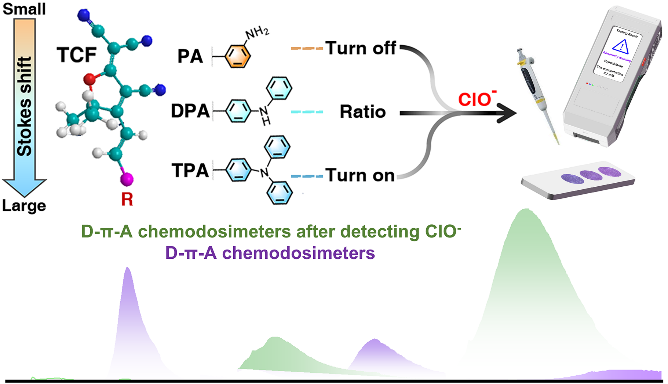Research Develop a Design Strategy of Triple-Standard Hypochlorite Quantitative Array Enabled by Precise Stokes Shift Modulation in D-π-A Chemodosimeters
Editor: | May 16,2025
As a typical oxidant, hypochlorite (ClO-) is widely used for sterilization, disinfection, and bleaching because of its strong oxidative properties. However, prolonged exposure to ClO- increases the risk for various human diseases, and excessive discharge can result in environmental pollution. Furthermore, calcium hypochlorite can be used to manufacture potassium or sodium perchlorate, one of the most frequently used raw materials for preparing improvised explosives. Therefore, realizing the rapid, highly sensitive, and visualized identification of ClO- is important for public health and environmental monitoring. However, the ClO- sensing always suffers from a low molar absorption coefficient, a narrow Stokes shift, complex synthesis, low sensitivity, and poor response speed, which limits their application in complex environments. Chemodosimeters, which detect analytes by initiating irreversible chemical reactions, are gaining increasing attention in the field of sensing due to their excellent selectivity for neutral molecules, high sensitivity, rapid response time, simplicity of design as well as high spatial and temporal resolution. Molecules with D-π-A structure, possess high conjugation polarization, adjustable band gap, and long-wavelength emission, have attracted considerable attention for design fluorescent chemodosimeter with large Stokes shifts due to the fact that it can enhance the visualization of the optical sensing signals by modulating the degree of π conjugation structure or the electron-releasing or electron-withdrawing ability of the substituents.
To address the ClO- sensing issue, a research team led by Prof. DOU Xincun from the Xinjiang Technical Institute of Physics and Chemistry of the Chinese Academy of Sciences (CAS) has developed a design strategy of triple-standard hypochlorite quantitative array enabled by precise Stokes shift modulation in D-π-A chemodosimeters. Their findings, published in Analytical Chemistry, emphasize tuning electron-releasing capability of the D-π-A chemodosimeters to improve the reactivity of the recognition site, the Stokes shifts, as well as the response speed and detection sensitivity toward the target analyte.
In this work, researchers based on the Claisen−Schmidt coupling reaction, a series of D-π-A fluorescent chemodosimeters (PA-TCF, DPA-TCF, TPA-TCF) with 2-(3-cyano-4,5,5-trimethylfuran-2(5H)-ylidene) malononitrile (TCF) as the electron-withdrawing group were synthesized by precisely modulating the electron-releasing strength (-PA>-DPA>-TPA), and the unsaturated double bond was generated as the ClO- recognition site. It is found that as the electron-releasing capability decreased, the fluorescence intensity of the chemodosimeters decreased owing to the π electron delocalization and π–π stacking within the conjugated system, the electrophilicity of the recognition site is increased by 1.449 kcal/mol, the sensing mode changes from fluorescence quenching to ratiometric fluorescence and finally to fluorescence on, and the Stokes shift of the chemodosimeter is improved to 201 nm, which improved the resolution of optical signal changes by the naked eye. Furthermore, the three D-π-A fluorescent chemodosimeters display superior sensing performance toward ClO-, including low limits of detection (LOD, 37.0, 5.1, and 1.0 nM), rapid response (<5 s), and great selectivity in the presence of 16 kinds of interferents. Moreover, considering the different detection performances of the chemodosimeters, the portable triple-standard quantitative array detection platform further verified the practical applicability of the chemodosimeter modulation strategy and realized the rapid, on-site and quantitative detection of ClO- in solution with errors between 13.75% and 9.5%. It is expected that the present significant Stokes shift chemodosimeter design and regulation strategy will not only provide a new idea for the sensitivity and rapid identification of oxidants but also promote the development of trace hazards detection methodologies.
This work was supported by the National Natural Science Foundation of China, the Tianshan Talents Plan, the Youth Innovation Promotion Association of the Chinese Academy of Sciences and the Tianshan Innovation Team Plan.

Figure: Schematic illustration of the designed strategy of the TCF-based D-π-A fluorescent chemodosimeters by the modulation of the electron-releasing strength
附件下载:
 (86) 991-3838931
(86) 991-3838931 lhskj@ms.xjb.ac.cn
lhskj@ms.xjb.ac.cn (86)991-3838957
(86)991-3838957 40-1 Beijing Road
Urumqi, XinjiangChina
40-1 Beijing Road
Urumqi, XinjiangChina